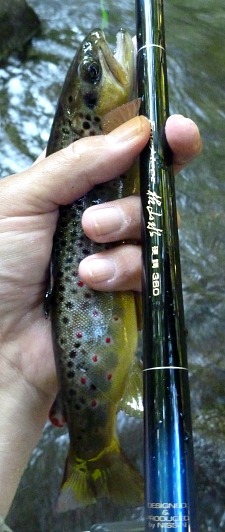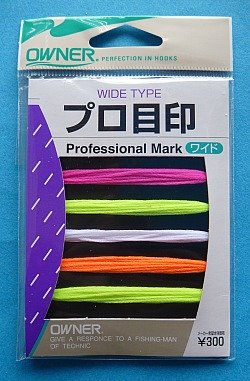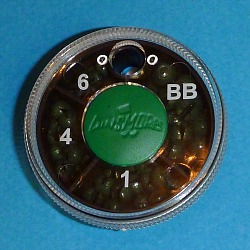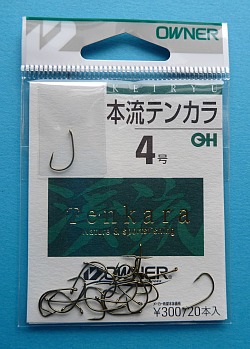Keiryu Trip - 9-19-14
Up until Friday, my
“keiryu fishing,” was pretty much limited to fishing bead head nymphs on keiryu
rigs. Last summer, I did one day of seiryu fishing with wax
worms. I caught fish like crazy. On a couple occasions, I have fished with nymphs taken from under rocks in the stream where I was fishing and I have caught a few fish doing so.
Friday, though,
was the first time I fished a keiryu rig with worms. Holy Mackerel! It wasn't a "many" day, it was a MANY, MANY day! Had I spent the entire day at the second stream I went to, it could very well have been a many, many, many day.
I went to two different streams. The first is a stream that is stocked in the spring. It has some natural reproduction but most of the trout in the stream are stocked, and by mid-September, the population is a small fraction of what it was on opening day. Plus, the water was very low, leaving few good lies. I ended up catching one fish, having one LDR that I almost got into the net (probably the same 13" rainbow shown on the Pocket Mini page), and I missed several others. With only one fish in the net I headed to the second stream.
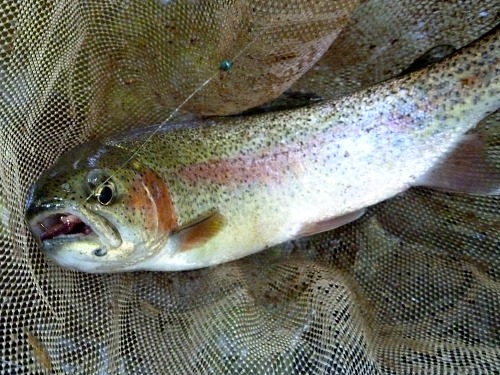
The fish in the second stream are much smaller but they're all wild. At least all the small ones are. The reservoir that the stream flows into is stocked but the stream itself isn't. I suspect some of the browns in the reservoir come into the stream to spawn but I rarely catch fish over 8" in the stream and the state doesn't stock fish that small. The stream is closed to fishing Oct 1 - Apr 1, so spawning fish don't get caught.
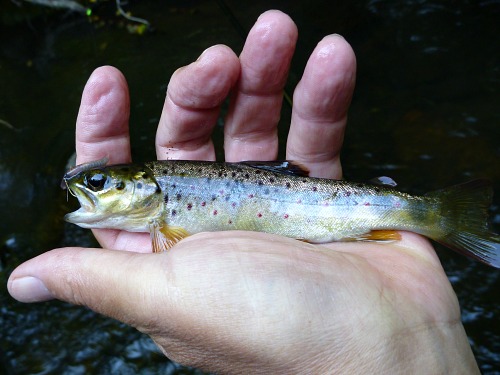
Most of the fish I caught in the second stream were about the size of the one above. A couple were a bit bigger, some were smaller, but they're all fun to catch - and I caught a lot of them. At one point very early on I thought "I didn't know there were this many fish in the stream."
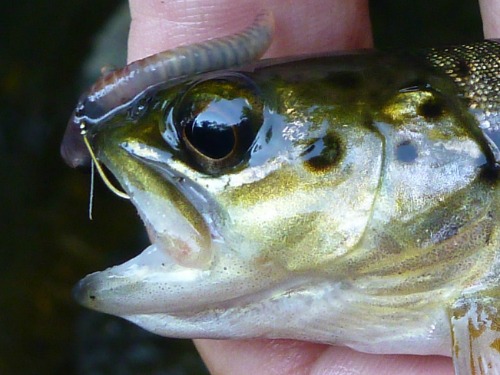
A bit over a year ago, I wrote a trip report after having fished a seiryu rod with wax worms and a small float. I had mentioned that all the fish were hooked right where you would hook fish when fishing with flies. The concerns over fish mortality from an "active" style of bait fishing, where you strike at the first hint of a take, just like in fly fishing, appear to be way overblown. I do agree that a "passive" style, where you delay your strike "to make sure he's got it" will result in deep hooking and increased mortality.
On Friday, I struck at the first hint of a take. I probably missed at least as many fish as I caught. Some certainly bit a part of the worm that didn't have the hook in it, some may have felt resistance from the tight line and spit out the worm, and for some I'm sure the hook just didn't catch as I tightened the line, pulling the worm (and the hook) right out of the fish's mouth.
The photos above are representative of where the fish were hooked. Deep hooking just wasn't an issue.
Despite missing many of fish, I caught lots and lots of fish. I can certainly understand why in Japan, where there aren't nearly the fish populations we have here, and where the fish are highly pressured, bait fishing is much more popular than tenkara. It's just a very effective way to fish.
There was a post recently on the Keiryu Anglers facebook group by a guy who has a friend really into tenkara, but who himself wasn't interested in fly fishing. Keiryu fishing may be just exactly what he is looking for.
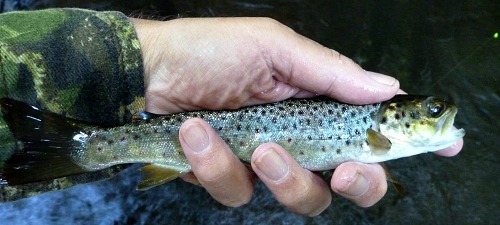
I started the day fishing with an almost standard keiryu rig, consisting of a Nissin Fine Mode Kosansui 4.5m rod, a size .8 line and yarn markers (just visible in the upper right corner of the photo above). I used a single #6 Dinsmore shot, which was more than enough for the low flows in each of the streams I fished. I did deviate from the standard set up by fishing with ayu line, which is hi-vis, rather than keiryu line, which is clear or black and definitely low vis. I also fished with Owner Mainstream Tenkara hooks, which have eyes, so I wouldn't have to snell hooks streamside. (How's that for turnabout? Using tenkara hooks for keiryu fishing!)
With a short line, about 2' shorter than the rod from rod tip to hook, I was able to use an underhand, pendulum cast to place the bait where I wanted when a regular overhead or side arm cast would have risked snags from streamside brush and branches. With practice, the pendulum cast also results in a quieter entry of the bait and shot.
Be ready for an immediate take, though! It was not unusual for me to get a hit almost right away.
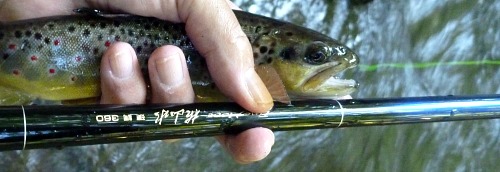
Later on, I switched to a shorter rod, the Nissin Fine Mode Kosansui 360. I also switched from the light keiru line to a hi-vis line of green Amnesia (visible in the background of the photo above). This is not the standard method of keiryu fishing in Japan. They use very light lines, ranging from Japanese line size .8 (equivalent to our 5X) down to a gossamer size .1 (thinner than Varivas 10X tippet). The lines are too thin to see so they use markers on the line. I have found that the markers cause wind resistance while casting, necessitating the use of heavier shot to overcome the wind resistance. Heavy shot gets snagged easily in a shallow, rocky stream.
A line that has enough weight to at least contribute to the weight being cast allows the use of lighter shot and should result in less snagging on the bottom. In a deeper, swifter stream, you'd need the weight to get down quickly anyway, but in a slower, shallow stream you really don't.
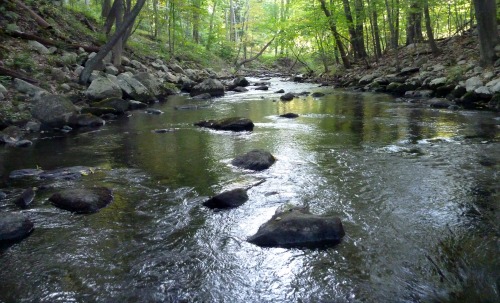
Probably the main advantages of the extremely light lines used in Japan are better drifts and less resistance felt by the fish after taking the bait. The biggest disadvantage is that they are essentially invisible, requiring the use of markers on the line, which cause wind resistance when casting. Although by far, most of the takes were felt on Friday, not all were, so you need to be able to see the strikes to make sure you can react quickly enough that the fish doesn't have time to swallow the hook.
I was surprised how many of the takes came almost immediately after the worm hit the water. I really didn't need to worry about getting drag-free drifts! Given that and the low light conditions resulting from the dense overhead canopy, the incredibly visible green Amnesia was actually a very effective line. Personally, I find the green Amnesia to be more visible than the red.
I have a lot more experimenting to do. I do think for deeper, swifter water, where you will want heavier shot or heavier bead head nymphs, using a very light line is better, as I suggested in my 7-6-14 trip report. For shallow, rocky streams, I think a slightly heavier line, enough to at least contribute to the weight being cast, will allow you to use less weight in the form of split shot or bead head and to forgo yarn markers. The ideal line for those conditions might well end up being nylon mono because of the inherently better visibility possible with nylon for the thinner lines.
One other thing I noticed on Friday, which I had never before considered, is that a worm has appreciable weight. I would not be surprised if the Suntech ZPRO 54 could cast a light (7X) line with just the weight of the worm itself. Markers would be necessary, but to keep wind resistance down they might have to be just knots with no tag ends
Too many questions, too little time.
TenkaraBum Home > Keiryu Trip Reports > Trip Report 9-19-14
“The bitterness of poor quality remains long after the sweetness of low price is forgotten” - Benjamin Franklin
"Be sure in casting, that your fly fall first into the water, for if the line fall first, it scares or frightens the fish..." -
Col. Robert Venables 1662
As age slows my pace, I will become more like the heron.
We've all had situations where seriously chewed up flies kept catching fish after fish after fish. It is no sin to tie flies that come off the vise looking seriously chewed up.
Warning:
The hooks are sharp.
The coffee's hot.
The fish are slippery when wet.
Beware of the Dogma
What's in stock?
Suntech Tenkarakyo 40F Tenkara Rods
Old Geezer's Wide-Eyed Fly Box
Coming Soon
December
Kurenai II AR 30F
Kurenai II AR 33F
Kurenai II AR 39F
Nissin Oni Line size 3
Nissin Oni Line size 3.5
January
Furaibo TF39
Furaibo TF39TA
February
TenkaraBum 33
TenkaraBum 36
TenkaraBum 40
Latest Pages
If you enjoy spin fishing or baitcasting please visit my sister site Finesse-Fishing.com.
Black Friday sale on now. 15% off on all Tenryu spinning and baitcasting rods.



